
Dessert is a course that concludes a meal. The course consists of sweet foods, such as cake, biscuit, ice cream and possibly a beverage such as dessert wine and liqueur. Some cultures sweeten foods that are more commonly savory to create desserts. In some parts of the world, there is no tradition of a dessert course to conclude a meal.
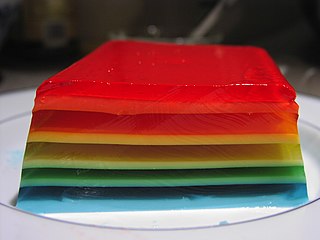
Gelatin desserts are desserts made with a sweetened and flavoured processed collagen product (gelatin), which makes the dessert "set" from a liquid to a soft elastic solid gel. This kind of dessert was first recorded as "jelly" by Hannah Glasse in her 18th-century book The Art of Cookery, appearing in a layer of trifle. Jelly recipes are included in the 19th-century cookbooks of English food writers Eliza Acton and Mrs Beeton.

Indonesian cuisine is a collection of various regional culinary traditions that formed in the archipelagic nation of Indonesia. There are a wide variety of recipes and cuisines in part because Indonesia is composed of approximately 6,000 populated islands of the total 17,508 in the world's largest archipelago, with more than 600 ethnic groups.
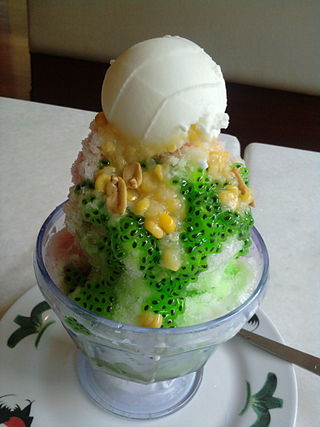
Ais kacang, literally meaning "bean ice", also commonly known as ABC, meaning "mixed ice"), is a dessert which is common in Malaysia, Singapore and Brunei.

Bingsu, sometimes written as bingsoo, is a milk-based Korean shaved ice dessert with sweet toppings that may include chopped fruit, condensed milk, fruit syrup, and red beans.

Grass jelly, also known as leaf jelly or herb jelly, is a jelly-like dessert originating in China. It is commonly consumed in East Asia and Southeast Asia. It is created by using Chinese mesona and has a mild, slightly bitter taste. Grass jelly was invented by the Hakka people who historically used the food to alleviate heat stroke after long days working in the field. The dish was introduced to Southeast Asia by the Chinese diaspora. It is served chilled, with other toppings, such as fruit, or in bubble tea or other drinks. Outside Asia, it is sold in Asian supermarkets.
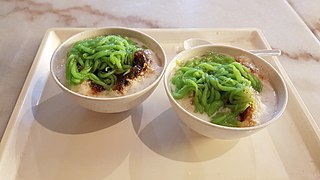
Cendol is an iced sweet dessert that contains pandan-flavoured green rice flour jelly, coconut milk, and palm sugar syrup. It is popular in the Southeast Asian nations of Indonesia, Malaysia, Brunei, Cambodia, East Timor, Laos, Vietnam, Thailand, Singapore, Philippines, and Myanmar. Next to the green jelly, additional toppings might be added, including diced jackfruit, sweetened red azuki beans, or durian.
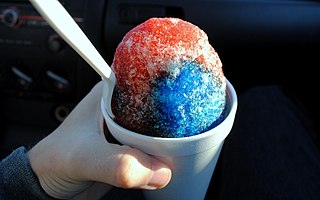
Shaved ice is a large family of ice-based desserts made of fine shavings of ice and sweet condiments or syrups. Usually, the syrup is added after the ice has been frozen and shaved—typically at the point of sale; however, flavoring can also be added before freezing. The dessert is consumed worldwide in various forms and ways. Shaved ice can also be mixed with large quantities of liquid to produce shaved ice drinks.

Es teler is an Indonesian fruit cocktail. Avocado, coconut meat, grass jelly, jackfruit and other fruits are served with coconut milk, sweetened condensed milk, Pandanus amaryllifolius leaf, sugar, and a tiny amount of salt.

Sundanese cuisine is the cuisine of the Sundanese people of Western Java, and Banten, Indonesia. It is one of the most popular foods in Indonesia. Sundanese food is characterised by its freshness; the famous lalab eaten with sambal and also karedok demonstrate the Sundanese fondness for fresh raw vegetables. Unlike the rich and spicy taste, infused with coconut milk and curry of Minangkabau cuisine, the Sundanese cuisine displays the simple and clear taste; ranged from savoury salty, fresh sourness, mild sweetness, to hot and spicy.
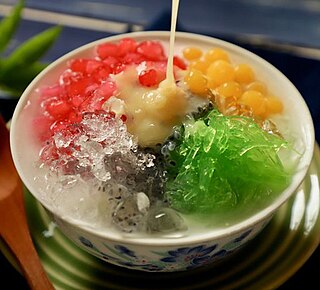
Es campur is an Indonesian cold and sweet dessert concoction of fruit cocktails, coconut, tapioca pearls, grass jellies, etc. served in shaved ice, syrup and condensed milk.

Namkhaeng sai is a Thai version of shaved ice or snow cone. It is also known as wan yen or chamba. Namkhaeng sai is simply shaved ice in a bowl, poured on top with sweet syrup and condensed milk. The word namkhaeng sai directly translated as "clear ice".

Es doger is an Indonesian coconut milk-based shaved ice beverage with pinkish color often served as a dessert. It is a specialty of Bandung, West Java. The main, or base, part is sugared sweet coconut milk-based ice in pink syrup, served with pacar cina merah delima, avocado, cassava tapai, ketan hitam tapai, jackfruit, diced bread and condensed milk. The condensed milk can be plain (white), or chocolate flavoured. Es doger gains its pinkish color from rozen (rose) syrup, cocopandan syrup, or pink food coloring. Es doger is commonly sold by travelling vendor carts in major Indonesian cities, mainly in Bandung, Jakarta, Malang and Surabaya.

Es kelapa muda is a beverage made from chilled or iced coconut water, young coconut flesh and syrup. It is among the most popular beverages in Indonesia. Es kelapa muda is included in the world's 50 most delicious drinks according to CNN on December 9, 2011, ranking 19th.
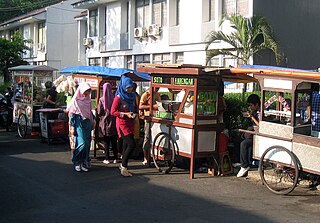
Indonesian street food is a collection of ready-to-eat meals, snacks, fruits and drinks sold by hawkers or vendors at warung food stalls or food carts. Street food in Indonesia is a diverse mix of local Indonesian, Chinese, and Dutch influences. Indonesian street food is usually cheap, offers a great variety of food of different tastes, and can be found at every corner of the city.

Nom yen is a sweet, iced beverage from Thailand. Known for its distinctive pink color, this drink is a fusion of milk and sala syrup made from salak fruit. It is widely enjoyed across Thailand and can be commonly found from street vendors and café, especially as a refreshing drink during the hot and humid months.

Samalamig, also known as palamig, is a collective term for various Filipino sweet chilled beverages that usually include jelly-like ingredients. They come in various flavors, and are commonly sold by street vendors as refreshments. Typical ingredients of the drinks include gulaman (agar), sago pearls, kaong, tapioca pearls, nata de coco, and coconut. They are usually anglicized as pearl coolers or pearl and jelly coolers.

Buko salad, usually anglicized as young coconut salad, is a Filipino fruit salad dessert made from strips of fresh young coconut (buko) with sweetened milk or cream and various other ingredients. It is one of the most popular and ubiquitous Filipino desserts served during celebrations and fiestas.

Madurese cuisine is the culinary tradition of the Madurese people from Madura Island in Indonesia. This cuisine is particularly well-known in the neighboring areas of East Java, as well as on the south coast of Kalimantan. As a leading salt production center in the Indonesian archipelago, Madurese dishes are often saltier compared to Eastern Javanese cuisine, although with significant Javanese influences.


















